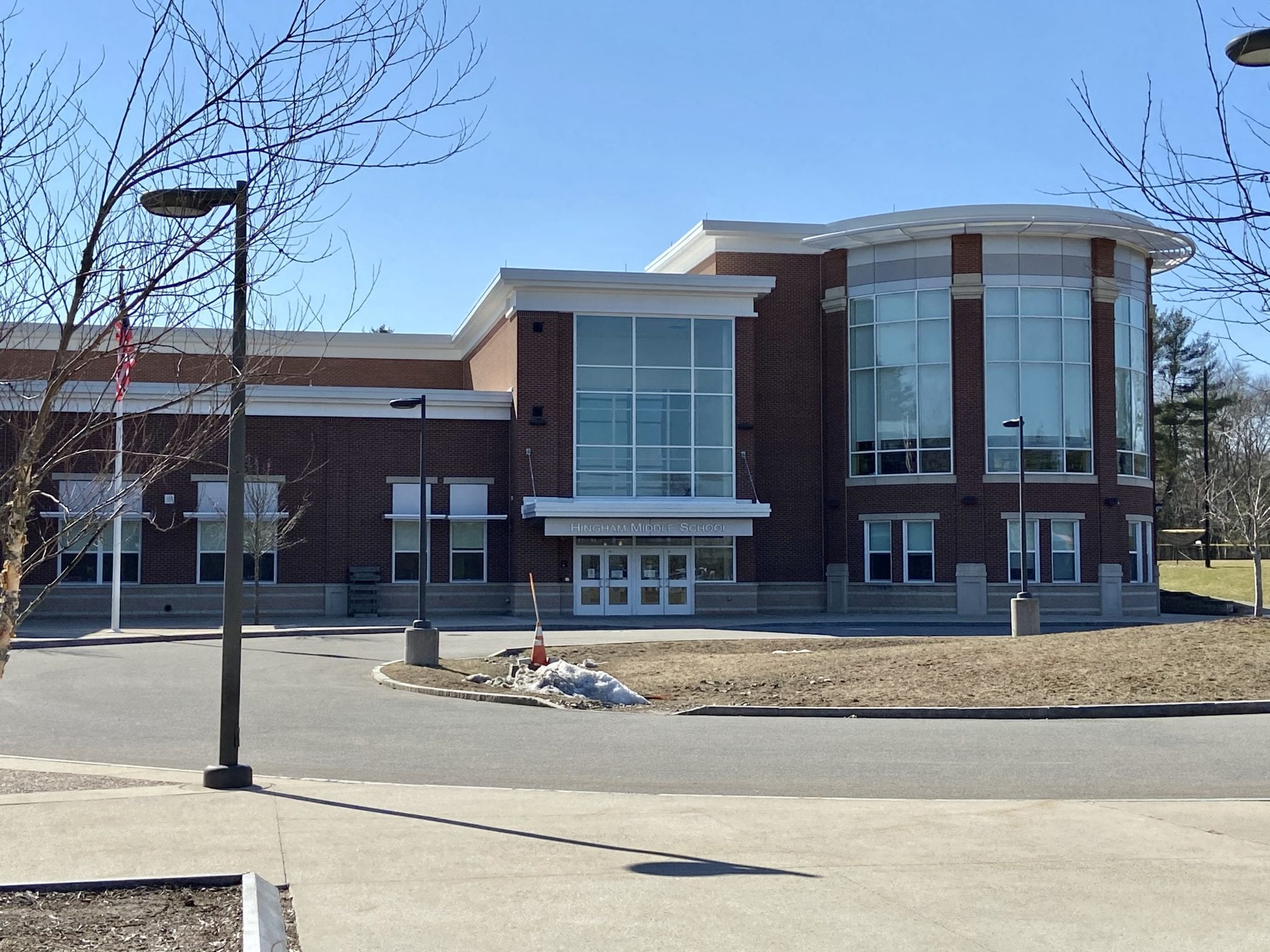
March 16, 2021 by Carol Britton Meyer
On Monday (March 15) -- the same day non-remote Hingham Public Schools elementary students returned to full in-person learning five days a week -- Supt. of Schools Paul Austin presented a proposal for phased-in approaches to returning non-remote Grades 6 through 8 and also grades 9 through 12 students to full in-person learning. This would result in the discontinuation of the hybrid learning model (a combination of remote and in-person instruction).
Implementation of the plan -- including the working conditions impacted by these proposals -- is contingent on ratification of an agreement by the Hingham Education Association through collective bargaining negotiations.
"We are currently meeting weekly with the HEA," Austin said.
He explained why a phased-in approach is recommended. "The district wanted to move to five days per week as quickly as possible, but there are many details that still need to be worked out," he said. "Starting five days per week on the current schedule will allow us the time needed to work out issues with space, schedules, and providing lunch that will hopefully ensure a smooth transition to full days after April vacation," subject to HEA approval.
"Our students and staff need time to adjust to the 'new normal,'" Austin said. "School will not be just like it was prior to the pandemic for the foreseeable future, and we must all adjust."
As previously agreed upon, on March 17, Hingham Middle School students will attend classes on alternating Wednesdays for four-hour days (7:30 to 11:30 a.m.) of in-person learning based upon cohort assignment.
"Blocks A through E will meet in-person, and most students will be dismissed at 11:30 a.m. to return home to participate in their elective classes remotely," Austin explained.
The proposal also calls for all non-remote HMS students to attend school five days per week, for 4-1/2 hours (7:30 – 11:55 a.m.) starting March 29. Blocks A through E would increase from 40 to 47 minutes each.
Most students would be dismissed at 11:55 a.m. to return home to participate in their elective classes remotely during the afternoon as they do now.
"From this date forward, the district [would] ensure at least three feet of physical distancing for all HMS students," Austin said.
Under the current proposal, on April 26, all HMS students would attend school five full days in-person, from 7:30 a.m. to 2 p.m., including lunch.
"Blocks A – G will meet in-person, but some elective classes may need to be limited due to enrollment, which may result in individual schedule changes," Austin said.
Hingham High School proposal
On April 5, all non-remote HHS students would attend school five days per week on the current schedule (8 a.m. – 12:05 p.m.) "From this date forward, the district [would] ensure at least three feet of physical distancing for all students," Austin said -- the same as at HMS.
On April 26, all HHS students would attend school five full days in-person, and lunch would be served. The school day would run from 8 a.m. – 2:30 p.m.
Overflow locations for students to livestream into their classes may be needed for classrooms that can't accommodate all students with 3-foot spacing, according to Austin.
Lunchtime, Austin said, would be a "very complex problem" and "a major hurdle to address," with all students spaced at least six feet apart and facing in the same direction.
"Lunch will not be the same social experience our students are accustomed to. With 900-plus students at HMS and over 1,200 at HHS, this is perhaps our greatest challenge," Austin said. "We have ordered 40- by 100-foot tents for both the Middle School and High School that will each hold more than 100 students, but this will not completely solve the issue."
Providing unmasked lunches and increased mask breaks (all at six-plus feet of physical distancing) could increase the transmission of COVID-19 in the HPS, according to Austin.
Strict adherence to all safety protocols (including wearing face masks, hand washing, and physical spacing) would continue to be required to minimize COVID-19 risks in the school community.
The district will ensure that educators maintain at least six feet of physical distancing from students at both the HMS and HHS.
Additional nursing staff may be needed
Because part of the proposal calls for three feet or more of physical distancing rather than six, additional nursing staff may be needed to account for expected increases in contact tracing in accordance with state requirements -- which involves notifying those who have come into contact with individuals who have tested positive.
"Reducing physical distancing from six feet to three-to-six feet will increase the potential number of children and staff subject to quarantine, entire class quarantine, or perhaps whole school quarantine (which would require a pivoting to remote learning)," Austin said. "Doing so also increases the risk of transmission in school. This [scenario] will need to be monitored carefully via pool testing and contact tracing."
Pooled testing -- involving testing a large group of staff/students at one time, with a quick turn-around for the results to come back -- is an important tool HPS can use to monitor the spread of COVID-19 among students, "but we have had relatively low 'buy-in' from students to participate [parental permission is required]," Austin said. "We hope [more students will agree to be pool-tested] as we move everyone back into the buildings. We'd like to see at least 50 percent participation -- which would be a whole lot more than we have now."
To assist in planning, HMS and HHS families will be asked to commit to in-person or remote learning for the remainder of the school year in order to limit enrollment/classroom changes between in-person and remote learning students as much as possible.
"Any changes after April 17 will be subject to space limitations and could take several weeks to implement," Austin said.
He went on to explain that while most HPS students have been attending school at least two days per week since September, as many as 30 percent of HHS students have been engaged in fully-remote learning.
"The two/three-week phase-in period will ease the transition for those students [who decide to move from remote to in-person learning]," Austin said.
HMS and HHS families can expect to hear from their building administrators with updates and schedule information.
Outdoor space
In order to safely conduct classes and activities such as physical education, music, and lunch, according to Austin, the plan is to utilize outdoor space often. "By April 26 we hope for warmer temperatures and better weather," he said.
Many HPS faculty and staff have already been, or are in the process of being, vaccinated. "It is our hope that by April 26, most of our educators and staff will have received at least one dose of the Moderna or Pfizer vaccine or perhaps even be fully vaccinated with the Johnson & Johnson [one-dose] vaccine," Austin said.
The HMS and HHS Advisory Committees will continue to meet to work through the issues associated with the return of students to full in-person learning.
In the meantime, Ni and fellow School Committee member Michelle Ayer heard input from about 40 HHS students and others via email -- during a remote forum. "Our sense is that the students are really excited about this opportunity to return to school -- they've missed their teachers and each other -- but that they are concerned about what lunch will look like [in particular]," Ayer said. "They asked us to make the lunch rules clear to the student body and how they need to be followed. There were also some concerns about the requirement of a minimum of three feet of physical distancing with 1,000 students in the hallways."
'Proceed with optimism, and caution'
While Ayer said brighter days are coming, "the pandemic is not over. Pooled testing is a great way to keep students and our community safe and will allow us to keep our schools open. This is exciting," Ayer said, suggesting "proceeding with optimism, but also with caution."
Parent Valerie Robin said while she recognizes that while many students may have valid reasons to remain with the remote learning model, she has noticed that some students who have chosen to learn in this way "are participating in extracurricular activities."
According to Austin, the state requires that the remote learning option be made available for the rest of this school year, but "the reason has to be COVID-related, even if a student just says he or she fears COVID."
Robin went on to say that she's "excited, thrilled, and supportive" about and of the full return to in-person learning and understands the challenges involved, while at the same time wondering how school administrators will keep "students, teachers, and administrators satisfied."
Parent Susan O'Horo suggested that students be required "to attest to their compliance with safety protocols" by indicating whether they have traveled recently and if so, whether it was done in compliance with COVID-19 travel restrictions and guidelines, whether they have had a fever, and other considerations to provide a level of confidence to fellow students that they are in a safe environment.
Austin thought this was a good idea and will consider O'Horo's suggestion.
Austin explained that the HPS beat Massachusetts Elementary & Secondary Education Commissioner Jeffrey Riley's April 5 deadline for elementary students to return to five-days-a-week of in-person learning in order to receive credit for Structured Learning Time.
If the HEA ratifies the proposal, HPS will again be ahead of the game by bringing HMS students back to the same learning model on April 26 -- two days before Riley's deadline.
No date has yet been set for the required return-to school-fulltime deadline for high school, but Austin is expected that announcement to be made soon. "This a clear end to hybrid learning," he said.
Austin emphasized that if any student's decision to stay on remote learning or to switch to remote learning moving forward is due to a lack of transportation, he or she should let a school administrator know and transportation will be provided.

